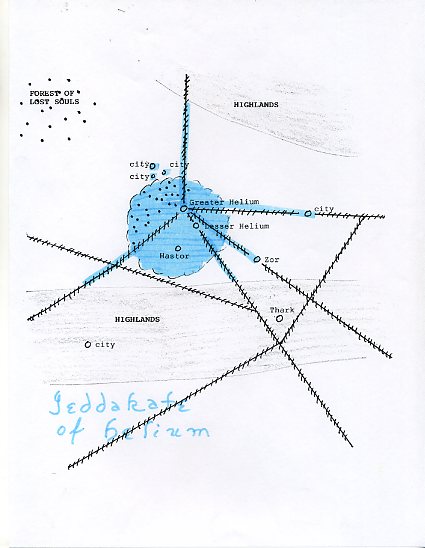

by: Rick Johnson 
PO Box 40451
Tucson, Az.
85717
RikJohnson@juno.com
Back to the Atlas main page.
Back to the Contents page.
Most nations of Barsoom are a single city-state with the surrounding farms that stretch along as much Waterway as that city can control and protect. Thus most modern nations are linear as there is no need to conquer a few miles of worthless desert.
An example of this is when I was stationed in the united Arab Emerates, I looked at a map of the nation and saw the UAE/Saudi Arabia border as a dotted line marked “undetermined.” When I asked about this, I was told, “that is just sand! Not even the camel spiders live there so why argue over worthless sand?” The same applies to Barsoom.
If the city is ancient or on an island, then it will establish a circular nation such as Gathol which was once an island and so the nation of Gathol was the entire island. As the seas receded, Gathol continued to expand circular until their current borders run against Kamtol in the west, and the coastline elsewhere.
As a city grows in power, it will conquer more and more croplands (remember that croplands follow then waterway as croplands in Egypt follow the Nile) until they come into conflict with another city and war ensues. The victor then changes from a city-state to an empire and the former Jed now claims the title of Jeddak or Great Jed or possibly Jed over Many Jeds.
There are few empires or Jeddakes on Barsoom as these are seem as dangerous. Ptarth, Helium, Jahar and Zodanga come to mind as the most famous. Here are some of the Empires of Barsoom in alphabetical order.


AMHOR is a former island nation north of the Toonol Marsh and so is basically circular. As the sea receded, waterways reached to the island and pumping stations were built at the base of the Amhor plateau to force the water to the top.
Amhor is unusual in that crops on Amhor, like Gathol, cover the entire surface of the former island and not in ribbons as is true with other nations. It is this massive surface area for foods that give Amhor her power.

DUSAR is an ancient city on the coast of the Throxus Ocean and so as a port city on the main river that connected Torquas to Throxus, became rich and powerful by controlling that sea and river trade much as New Orleans and Cairo did. As the seas receded, Dusar received a number of waterways which fell under her control though she lost the power of an important coastal/river delta city that was once hers.

HELIUM is anew nation founded since the oceans dried up. Once the valley was home to the Green Hoards that crossed the southern arid regions, it was colonized and the Green men driven out. Helium originally controlled the entire valley (actually a massive meteoric impact crater) and some of the surrounding satellite cities that lie on nearby waterways. Her wealth comes form the forests that lie along the NW wall of the valley and the nickel-iron asteroid that impacted to create one of the largest iron mines on Barsoom.
Since the coming of John Carter, Helium has become a super-power, conquering Zodanga and Jahar (though they chose to release Jahar to a puppet Jeddak) and a number of other nations.

PTARTH is an ancient Empire that once controlled the entire land from the Artolian Hills to the Throxus Ocean, from the Phundahl Hills to the Northern ice-cap. With the growing desert, her power was reduced but she still controls many of the waterways and tributary cities that stretch through her former lands.

ZODANGA was once one of the great empires until she made the mistake of capturing Dejah Thoris, Princess of Helium and used her in a bid to conquer that city and her wealth. John Carter united the Heluimites with the Tharken Hoard and swept Zodanga from the role of an Empire to simple vassel-states of Helium.
Back to the Atlas main page.
Back to the Contents page.

To contact me or to request topics to be covered, send to RikJohnson@juno.com
by: Rick Johnson 
PO Box 40451
Tucson, Az.
85717
